|
 
- UID
- 1023166
- 性别
- 男
- 来自
- 燕山大学
|

Embest NXP LPC1788 32位ARM Cortex-M3 MCU开发方案
Embest公司的EM-LPC1788开发板是基于NXP公司的LPC1788 32位ARM
Cortex-M3 MCU,采用JTAG仿真和调试以及ISP编程,支持各种电源如USB2UART mini USB/USB1/USB2/EXT 5V,主要用在通信如POS终端,网络服务器和多协议桥,工业/医疗如自动化控制,应用控制,机器人控制,HVAC PLC和逆变器等,消费类电子如音频,MP3译码,告警系统,显示器,打印机和小型设备以及汽车电子如汽车告警,GPS监视器等.本文介绍了LPC178x/7x系列主要特性和优势,框图,EM-LPC1788开发板硬件指标和软件指标,框图和电路图.
The LPC178x/7x is an ARM Cortex-M3 based microcontroller for embedded applications requiring a high level of integration and low power dissipation.
The Cortex-M3 is a next generation core that offers better performance than the ARM7 at the same clock rate and other system enhancements such as modernized debug features and a higher level of support block integration. The Cortex-M3 CPU incorporates a 3-stage pipeline and has a Harvard architecture with separate local instruction and data buses, as well as a third bus with slightly lower performance for peripherals. The Cortex-M3 CPU also includes an internal prefetch unit that supports speculative branches.
The LPC178x/7x adds a specialized flash memory accelerator to accomplish optimal performance when executing code from flash. The LPC178x/7x operates at up to 120 MHz CPU frequency.
The peripheral complement of the LPC178x/7x includes up to 512 kB of flash program memory, up to 96 kB of SRAM data memory, up to 4032 byte of EEPROM data memory, External Memory Controller (EMC), LCD (LPC178x only), Ethernet, USB Device/Host/OTG, a General Purpose DMA controller, five UARTs, three SSP controllers, three I2C-bus interfaces, one eight-channel, 12-bit ADC, a 10-bit DAC, a Quadrature Encoder Interface, four general purpose timers, two general purpose PWMs with six outputs each and one motor control PWM, an ultra-low power RTC with separate battery supply and event recorder, a windowed watchdog timer, a CRC calculation engine, up to 165 general purpose I/O pins, and more. The pinout of LPC178x/7x is intended to allow pin function compatibility with the LPC24xx and LPC23xx.
LPC178x/7x系列主要特性和优势:
Functional replacement for the LPC23xx and LPC24xx family devices.
System:
ARM Cortex-M3 processor, running at frequencies of up to 120 MHz. A Memory Protection Unit (MPU) supporting eight regions is included.
ARM Cortex-M3 built-in Nested Vectored Interrupt Controller (NVIC).
Multilayer AHB matrix interconnect provides a separate bus for each AHB master.
AHB masters include the CPU,USB, Ethernet, and the General Purpose DMA controller. This interconnect provides communication with no arbitration delays unless two masters attempt to access the same slave at the same time.
Split APB bus allows for higher throughput with fewer stalls between the CPU and DMA. A single level of write buffering allows the CPU to continue without waiting for completion of APB writes if the APB was not already busy.
Cortex-M3 system tick timer, including an external clock input option.
Standard JTAG test/debug interface as well as Serial Wire Debug and Serial WireTrace Port options.
Embedded Trace Macrocell (ETM) module supports real-time trace.
Boundary scan for simplified board testing.
Non-maskable Interrupt (NMI) input.
Memory:
Up to 512 kB on-chip flash program memory with In-System Programming (ISP)and In-Application Programming (IAP) capabilities. The combination of an enhanced flash memory accelerator and location of the flash memory on the CPU local code/data bus provides high code performance from flash.
Up to 96 kB on-chip SRAM includes:
64 kB of main SRAM on the CPU with local code/data bus for high-performance CPU access.
Two 16 kB peripheral SRAM blocks with separate access paths for higher throughput. These SRAM blocks may be used for DMA memory as well as for general purpose instruction and data storage.
Up to 4032 byte on-chip EEPROM.
LCD controller, supporting both Super-Twisted Nematic (STN) and Thin-Film Transistors (TFT) displays.
Dedicated DMA controller.
Selectable display resolution (up to 1024 x 768 pixels).
Supports up to 24-bit true-color mode.
External Memory Controller (EMC) provides support for asynchronous static memory devices such as RAM, ROM and flash, as well as dynamic memories such as single data rate SDRAM with an SDRAM clock of up to 80 MHz.
Eight channel General Purpose DMA controller (GPDMA) on the AHB multilayer matrix that can be used with the SSP, I2S, UART, CRC engine, Analog-to-Digital and Digital-to-Analog converter peripherals, timer match signals, GPIO, and for memory-to-memory transfers.
Serial interfaces:
Ethernet MAC with MII/RMII interface and associated DMA controller. These functions reside on an independent AHB.
USB 2.0 full-speed dual-port device/host/OTG controller with on-chip PHY and associated DMA controller.
Five UARTs with fractional baud rate generation, internal FIFO, DMA support, and RS-485/EIA-485 support. One UART (UART1) has full modem control I/O, and one UART (USART4) supports IrDA, synchronous mode, and a smart card mode conforming to ISO7816-3.
Three SSP controllers with FIFO and multi-protocol capabilities. The SSP controllers can be used with the GPDMA.
Three enhanced I2C-bus interfaces, one with a true open-drain output supporting the full I2C-bus specification and Fast-mode Plus with data rates of 1 Mbit/s, two with standard port pins. Enhancements include multiple address recognition and monitor mode.
I2S-bus (Inter-IC Sound) interface for digital audio input or output. It can be used with the GPDMA. CAN controller with two channels.
Digital peripherals:
SD/MMC memory card interface.
Up to 165 General Purpose I/O (GPIO) pins depending on the packaging with configurable pull-up/down resistors, open-drain mode, and repeater mode. All GPIOs are located on an AHB bus for fast access and support Cortex-M3 bit-banding. GPIOs can be accessed by the General Purpose DMA Controller. Any pin of ports 0 and 2 can be used to generate an interrupt.
Two external interrupt inputs configurable as edge/level sensitive. All pins on port 0 and port 2 can be used as edge sensitive interrupt sources.
Four general purpose timers/counters with a total of eight capture inputs and ten compare outputs. Each timer block has an external count input. Specific timer events can be selected to generate DMA requests.
Quadrature encoder interface that can monitor one external quadrature encoder.
Two standard PWM/timer blocks with external count input option.
One motor control PWM with support for three-phase motor control.
Real-Time Clock (RTC) with a separate power domain. The RTC is clocked by a dedicated RTC oscillator. The RTC block includes 20 bytes of battery-powered backup registers, allowing system status to be stored when the rest of the chip is powered off. Battery power can be supplied from a standard 3 V lithium button cell.
The RTC will continue working when the battery voltage drops to as low as 2.1 V. An RTC interrupt can wake up the CPU from any reduced power mode.
Event Recorder that can capture the clock value when an event occurs on any of three inputs. The event identification and the time it occurred are stored in registers. The Event Recorder is located in the RTC power domain and can therefore operate as long as there is RTC power.
Windowed Watchdog Timer (WWDT). Windowed operation, dedicated internal oscillator, watchdog warning interrupt, and safety features.
CRC Engine block can calculate a CRC on supplied data using one of three standard polynomials. The CRC engine can be used in conjunction with the DMA controller to generate a CRC without CPU involvement in the data transfer.
Analog peripherals:
12-bit Analog-to-Digital Converter (ADC) with input multiplexing among eight pins, conversion rates up to 400 kHz, and multiple result registers. The 12-bit ADC can be used with the GPDMA controller.
10-bit Digital-to-Analog Converter (DAC) with dedicated conversion timer and GPDMA support.
Power control:
Four reduced power modes: Sleep, Deep-sleep, Power-down, and Deep power-down.
The Wake-up Interrupt Controller (WIC) allows the CPU to automatically wake up from any priority interrupt that can occur while the clocks are stopped in Deep-sleep, Power-down, and Deep power-down modes.
Processor wake-up from Power-down mode via any interrupt able to operate during Power-down mode (includes external interrupts, RTC interrupt, PORT0/2 pin interrupt, and NMI).
Brownout detect with separate threshold for interrupt and forced reset.
On-chip Power-On Reset (POR).
Clock generation:
Clock output function that can reflect the main oscillator clock, IRC clock, RTC clock, CPU clock, USB clock, or the watchdog timer clock.
On-chip crystal oscillator with an operating range of 1 MHz to 25 MHz.
12 MHz Internal RC oscillator (IRC) trimmed to 1% accuracy that can optionally be used as a system clock.
An on-chip PLL allows CPU operation up to the maximum CPU rate without the need for a high-frequency crystal. May be run from the main oscillator or the internal RC oscillator.
A second, dedicated PLL may be used for USB interface in order to allow added flexibility for the Main PLL settings.
Versatile pin function selection feature allows many possibilities for using on-chip peripheral functions.
Unique device serial number for identification purposes.
Single 3.3 V power supply (2.4 V to 3.6 V). Temperature range of 40 C to 85 C.
Available as LQFP208, TFBGA208, TFBGA180, and LQFP144 package.
LPC178x/7x应用:
Communications:
Point-of-sale terminals, web servers, multi-protocol bridges
Industrial/Medical:
Automation controllers, application control, robotics control, HVAC, PLC, inverters, circuit breakers, medical scanning, security monitoring, motor drive, video intercom
Consumer/Appliance:
Audio, MP3 decoders, alarm systems, displays, printers, scanners, small appliances, fitness equipment
Automotive:
After-market, car alarms, GPS/fleet monitors
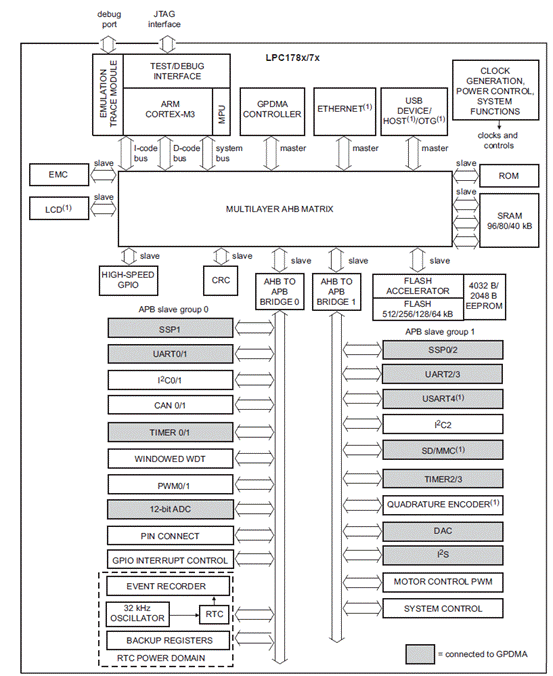
图1.LPC178x/7x方框图
EM-LPC1788开发板
EM-LPC1788 is a development board based on the main chip LPC1788 which is produced by NXP. The evaluation board is based on Cortex-M3 core, JTAG simulation and debug, and ISP programming. It supports variety of power supply, such as USB2UART mini USB/USB1/USB2/EXT 5V.
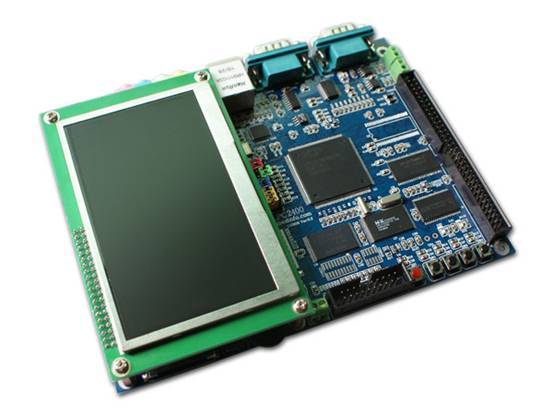
图2.EM-LPC1788开发板外形图
EM-LPC1788开发板硬件指标:
Hardware Specification:
| Hardware Specification
| Description
| Processor
| NXP LPC1788,Cortex-M3,120MHZ
| Memory
| Internal Memory:512KB SPI flash
96KB SRAM
| External Memory:128MB NAND FLASH
32MB SDRAM
4MB NOR FLASH
1MB SRAM
| Debug
| 20-pin JTAG Debug interface
Support JTAG and SWD mode.
| Storage
| One SD card interface
| Serial
| One USB to Serial interface
Two UART interfaces and one of them can be used as modem interface
| USB
| Three micro USB interfaces
Two USB Host interfaces
| CAN
| Two CAN interfaces
| Audio
| Two I2S audio input interfaces
Two I2S audio output interfaces
| ADC
| One ADC adjustable potentiometer
| Net
| One 10/100M Ethernet interface
| Expansion
| 64-pin I/O user expansion interface
| Keys
| Four Push button
| One Reset button
| Power Supply
| Support USB2UART mini USB/USB1/USB2/EXT 5V
|
| EM-LPC1788开发板软件指标:
| Module
| Examples
| Realize Functions
| ADC
| 01 ADC_Interrupt
| ADC Conversion in Interruption model
| 02 ADC_Polling
| ADC Conversion in Polling model
| CAN
| 03 Can_Selftest
| Test Can_Selftest model
| CRC
| 04 Crc_Demo
| Apply in CRC via LPC1788
| DAC
| 05 Dac_Dma
| Send or Receive data via DAC and DMA converter
| 06 Dac_SineWave
| Generate sine wave via DAC
| DMA
| 07 DMA_Flash2Ram
| Transmit data from flash to RAM to test GPDMA
| EEPROM
| 08 EEprom_Demo
| EEPROM Work mechanism in LPC1788
| GPIO
| 09 GPIO_Interrupt
| Test GPIO Interruption function
| 10 GPIO_LedBlinky
| Drive LED to test GPIO Interruption function
| NVIC
| 11 Nvic_VectorTableRelocation
| Vector Table Relocation
| EMC
| 12 NandFlash
| Test Expansion Nandflash chip
| 13 NorFlash
| Test Expansion Norflash chip
| 14 SRAM
| Test Expansion SRAM chip
| 15 SDRAM
| Test Expansion SDRAM chip
| PWM
| 16 Pwm_SingleEdge
| Use PWM signal in Single Edge model
| 17 Pwm_DualEdge
| Generate PWM signal in Dual Edge model
| 18 Pwm_MatchInterrupt
| Use PWM match function in Interruption model
| RTC
| 19 Rtc_Alarm
| Generate alarm interruption per 10 seconds
| Systick
| 20 Systick_10msBase
| Configure system clock to generate interruption per 10 seconds.
| TIMER
| 21 TIMER_MatchInterrupt
| Generate specific time
| PWR
| 22 PWR_Sleep
| Make system to Sleep mode and awaken by external interruption
| 23 PWR_DeepSleep
| Make system to Deep sleep mode and awaken by external interruption
| EMAC
| 24 Emac_EasyWeb
| Ethernet port test,realize a simple web apply.
| LCD
| 25 Lcd_LQ043T3DX0A
| Test LCD,Display specific picture
| 26 Lcd_touchscreen
| Touchscreen test
| TouchScreen
| 27 SSP_Touchscreen
| Catch Touchscreen coordinates via SSP
| WDT
| 28 Wdt_Interrupt
| Generate interruption at a Specific time via WDT
| 29 Wdt_Reset
| Reset chip at a Specific time via WDT
| MCI
| 30 Mci_CidCard
| Test SD card module
| USB
| 31 Usb_MassStorage
| Board is mapped to be moving storage in PC
| 32 Usb_VirtualCom
| Configure and make USB to be a virtual Com
| IIS
| 33 IIS_Audio
| Test audio module
| IIC
| 34_IIC_EEPROM
| Read and write external EEPROM via IIC
| uC/OS
| 35_UCOSII_V2.54
| Ucos Realtime system example test
|
|
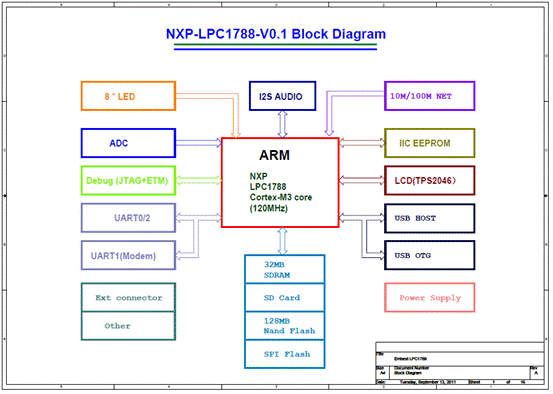
图3.EM-LPC1788开发板方框图
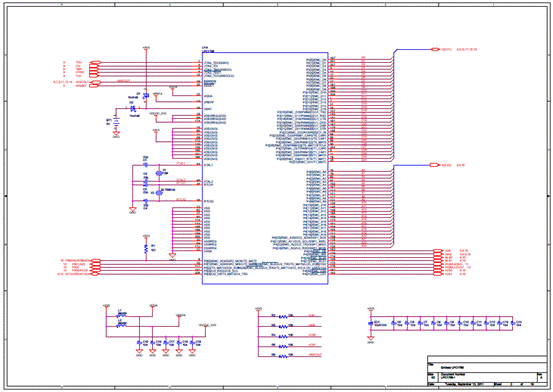
图4.EM-LPC1788开发板电路图(1)
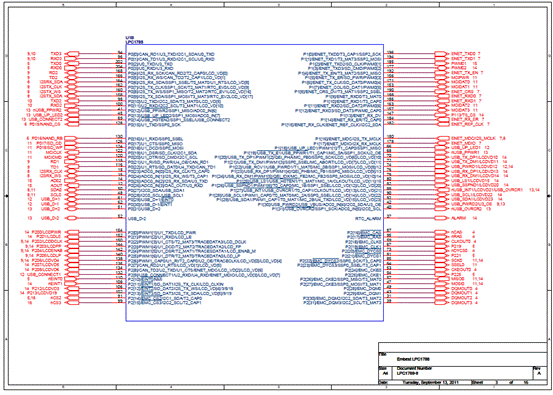
图5.EM-LPC1788开发板电路图(2)
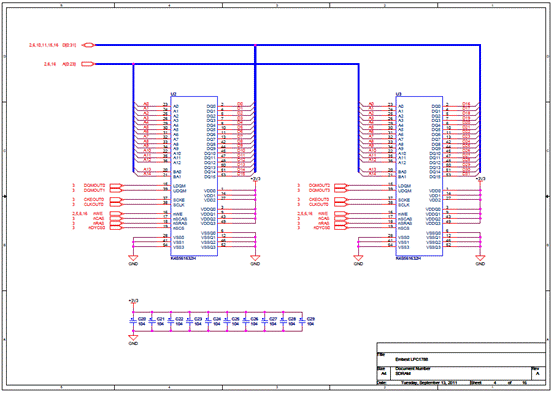
图6.EM-LPC1788开发板电路图(3)
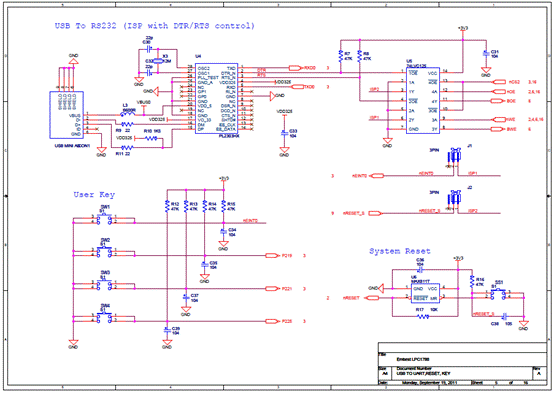
图7.EM-LPC1788开发板电路图(4)
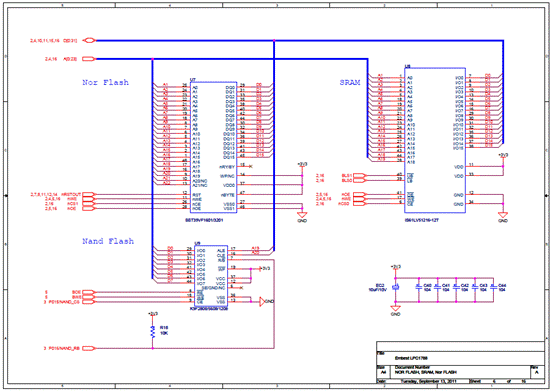
图8.EM-LPC1788开发板电路图(5)
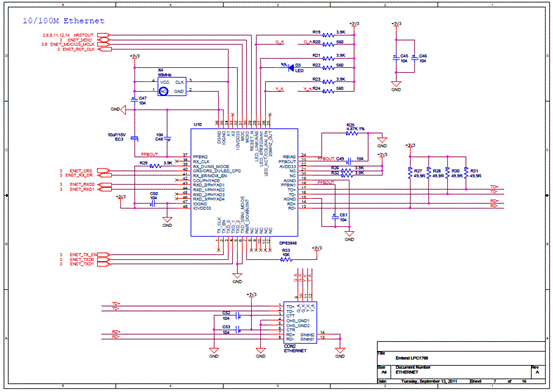
图9.EM-LPC1788开发板电路图(6)
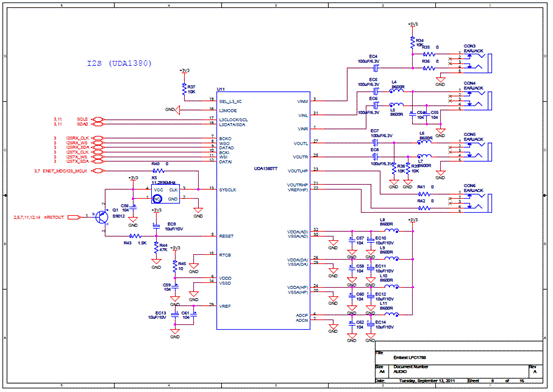
图10.EM-LPC1788开发板电路图(7)
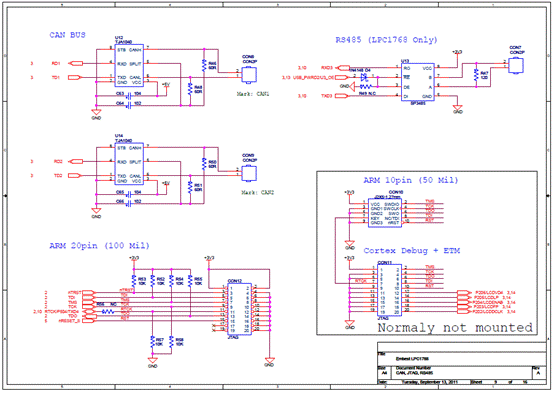
图11.EM-LPC1788开发板电路图(8)
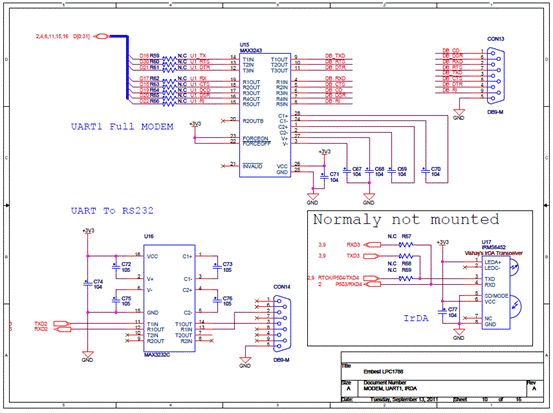
图12.EM-LPC1788开发板电路图(9)
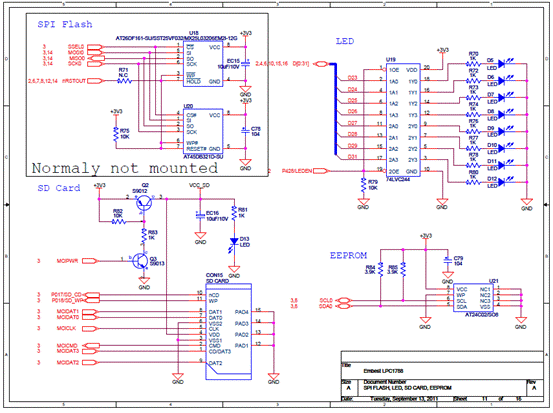
图13.EM-LPC1788开发板电路图(10)
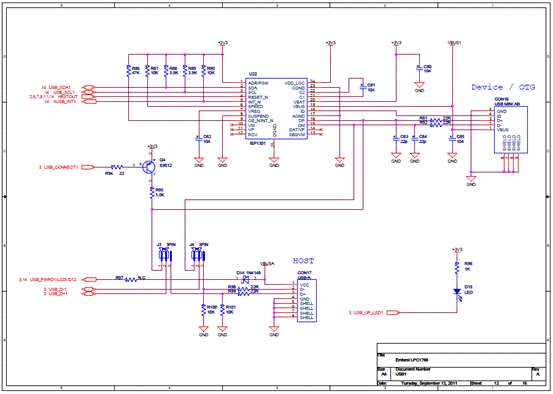
图14.EM-LPC1788开发板电路图(11)
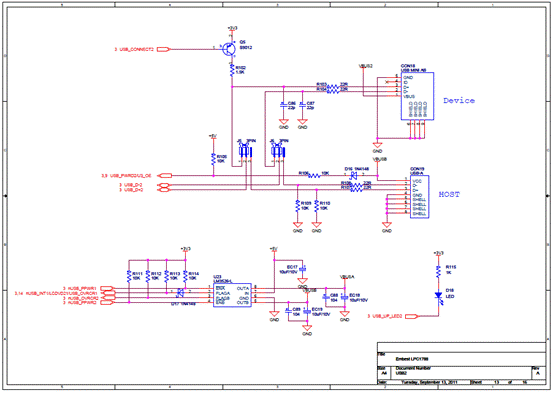
图15.EM-LPC1788开发板电路图(12)
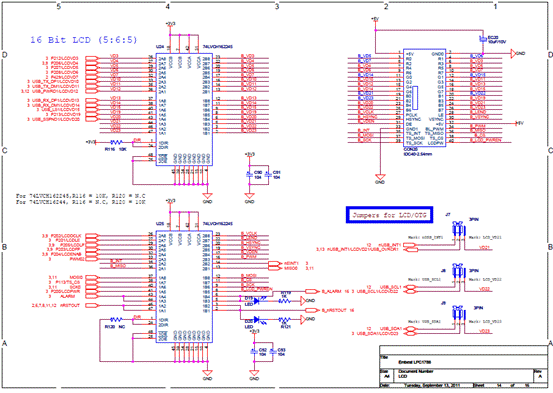
图16.EM-LPC1788开发板电路图(13)
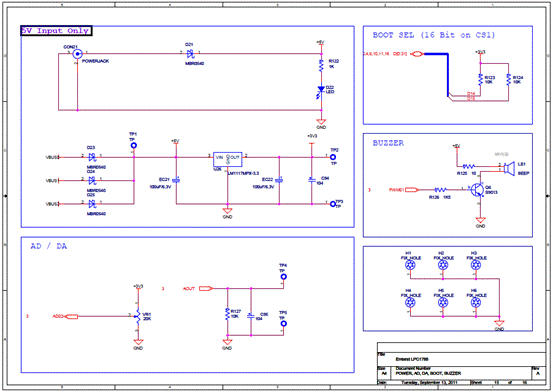
图17.EM-LPC1788开发板电路图(14)
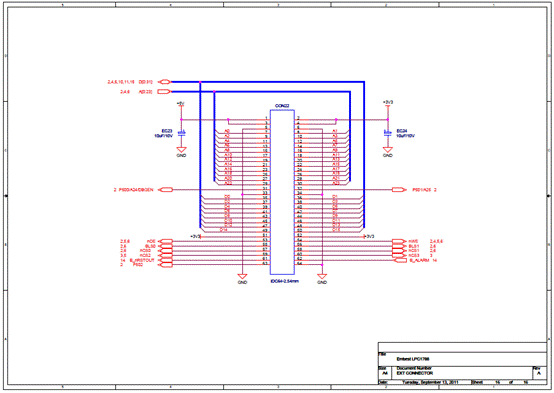
图18.EM-LPC1788开发板电路图(15)
详情请见:
 LPC178X_7X[1].pdf (1.55 MB, 下载次数: 19) 和 LPC178X_7X[1].pdf (1.55 MB, 下载次数: 19) 和
 EM-LPC1788_Schematic[1].pdf (250.69 KB, 下载次数: 19) EM-LPC1788_Schematic[1].pdf (250.69 KB, 下载次数: 19) |
|

